by R. S. MacKay
1. Introduction

Colin’s interest in cosmology came to my attention when I saw that he would give the first Warwick Mathematics Institute colloquium in our new building (December 2003), with title “A new paradigm for the universe”. In the end, the safety checks had not yet been completed, so he gave it in the old building. Nonetheless, to mark the occasion, the Physics Department kindly presented a photograph showing the new building at the centre of the universe (actually, the centre of the M31 galaxy) (Figure 1).
To summarise Colin’s talk, here is the abstract for the paper he put
on arXiv the month before
[1]:
A new paradigm for the structure of galaxies is proposed. The main hypothesis is that a normal galaxy contains a hypermassive black hole at its centre which generates the spiral arms. The paradigm gives satisfactory explanations for:
- the rotation curve of a galaxy;
- the spherical bulge at the centre of a normal galaxy;
- the spiral structure and long-term stability of a normal galaxy;
- the age and orbits of globular clusters;
- the origin and prevalence of solar systems;
- (highly speculative) the origin of life.
The paradigm is compatible with direct observations but not with many of the current interpretations of these observations. It is also incompatible with large swathes of current cosmological theory and in particular with the expanding universe and hot big-bang theories. A tentative new explanation for the observed redshift of distant objects is given which is compatible with a static model for the universe. This paper is being circulated in a very preliminary form in the hope that others will work both on interpreting observational data in the light of the new paradigm and on the obvious gaps in underlying theory.
Far reaching! Subsequently, Colin developed his ideas further, including firming up the promised explanation of redshift. It culminated in a book The Geometry of the Universe [6], which forms the basis for this review.
I found Colin’s talk somewhat whacky, but several aspects resonated with me, in particular that the big-bang story is over-simplistic, that redshift could have alternative explanations, and that dark matter is wild speculation. So I took up his invitation “to help complete the work” [1] and we began talking about it.
2. Galaxies
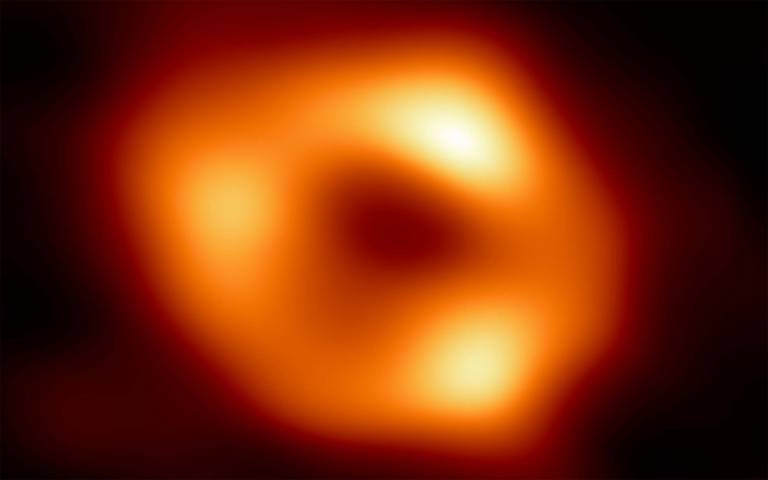
Colin’s paradigm starts with galaxies. In
particular, he proposed that they have a hypermassive black hole at
their centre. This might not sound revolutionary, because it was
proposed more than 50 years ago
[e6].
Furthermore, images have
been produced recently of the gas cloud around proposed black holes at
the centres of the Messier 87 galaxy and our own one (Figure 2). But although the mass of the observed black hole Sgr A
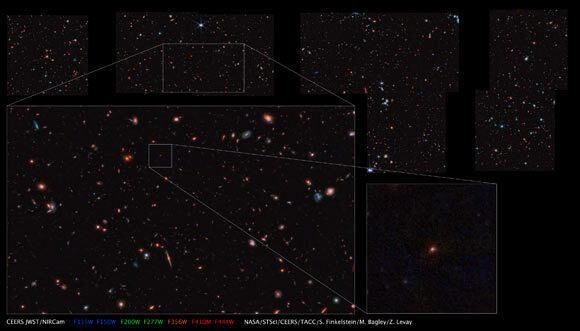
He proposed that galaxies with spiral arms are around
A key ingredient of Colin’s new paradigm for galaxies is an
inertial-drag effect due to rotation of the central black hole.
Einstein’s general relativity is known to produce inertial-drag
effects, that is, Coriolis and centrifugal forces in frames that do not
appear to be rotating. In particular, the Lense–Thirring effect makes
an effective frame-rotation rate
Colin uses this inertial drag law to explain the rotation curves of galaxies and to reinterpret quasars. I’ll address the rotation curves first.
The conundrum of the rotation curves of galaxies is that according to
Newtonian gravity the tangential speed of matter outside the main mass
of a galaxy should decrease like
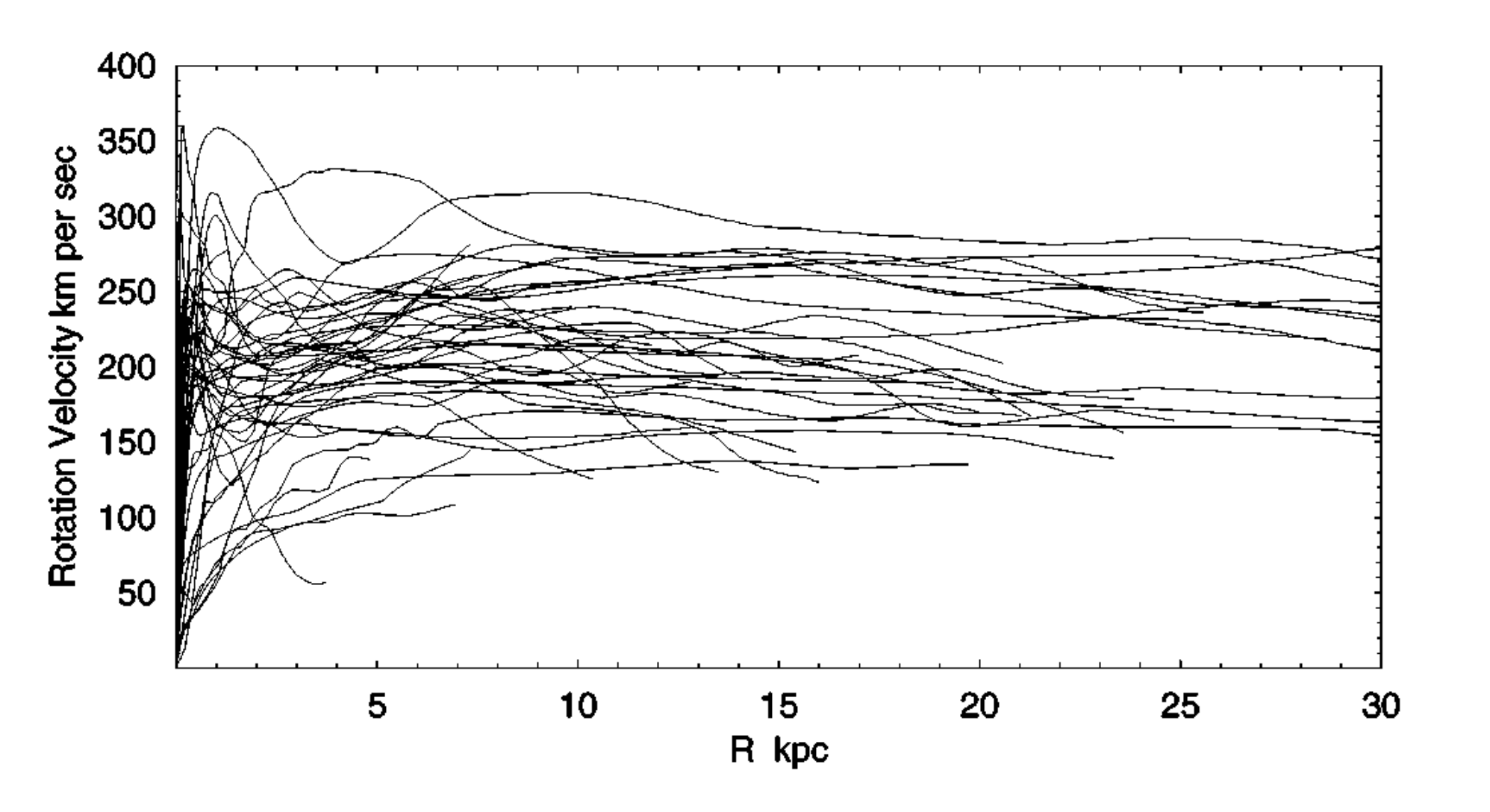
Sciama’s version of Mach’s principle is that “the statement that the
Earth is rotating and the rest of the universe is at rest should lead
to the same dynamical consequences as the statement that the universe
is rotating and the Earth is at rest”
[e2].
Thus, rotation of
bodies in the universe should produce Coriolis effects. Mach’s
principle is plausible but appears incompatible with Einstein’s
general relativity, despite having been part of the inspiration for
it. So Colin is making a modification to standard physics here. But he
is in good company: Sciama was an outstanding physicist, PhD student
of Dirac and supervisor of many influential cosmologists, including
Stephen Hawking. On the other hand, Mach’s principle has also been
addressed by Pietronero
[e8],
who derived a frame-dragging effect
Colin’s explanation of rotation curves gives asymptotic tangential
speed of for large momentum
are defined, not its angular velocity
3. Quasars
Next, Colin used his inertial drag law to give a new interpretation of
quasars. These “quasistellar radio sources” are, according to
standard theory, large black holes (up to
Colin drafted a paper on his model for quasars [5], asking our joint PhD student Rosemberg Toalá-Enríquez and me to fill in some parts. I still haven’t managed the parts Colin asked me to do (making a realistic model for the profiles of density, temperature and ionisation fraction, to find the principal location from which the radiation comes), nor did I understand sufficiently Colin’s proposal about ignoring angular momentum, and I felt somewhat uncomfortable having my name on the draft, so resisted for a while but he prevailed. Rereading it now, I understand his argument better. It would still be good to examine his proposal in more detail (see the Appendix to this review).
4. The HLSW law
As can be inferred from his abstract, another important topic of Colin’s work is reinterpreting Hubble’s law. Hubble’s law is that the radiation received from objects is redshifted by an amount proportional to their luminosity distance.
First, Colin makes some comments on nomenclature. It was acknowledged by the International Astronomical Union in 2018 that credit for Hubble’s law should be shared with Lemaître. Colin and I certainly share this view and I have followed some of Lemaître’s history. Figure 5 shows the college in Leuven where he lived around this time (the Katholieke Universiteit had a college system with a history to rival Oxbridge’s). Colin argues that the discovery of the law goes back to Slipher and Weyl, so he refers to it as the HLSW law. Certainly, Lemaître used Slipher’s observational data.

The HLSW law is where our collaboration began. First we played around with the thought that it could be a cumulative result of null geodesics passing through fluctuations in the metric; we didn’t reach a conclusion, but see Section 7. Then after a study in spherically symmetric space-times [3], we found that the HLSW law is a feature of all space-times having what we called a “natural observer field” [2] (note that although written after [3], it was published earlier). Perhaps there is a better name, but we defined a natural observer field to be a timelike vector field whose integral curves are geodesic and whose perpendicular plane field is integrable. This generalises the concept of the “Hubble flow”, the vector field on a Friedmann universe pointing purely in the time direction (in “comoving coordinates”), along which all matter is assumed (approximately) to flow (and would be better called the Friedmann flow since it was part of Friedmann’s model). In particular, a natural observer field induces a coherent notion of time: constant on the perpendicular space-slices and whose difference between two space-slices is the proper time along any fieldline.
For any object, radiation emitted at frequency
We found de Sitter space to provide an instructive example
[2],
[3].
De Sitter
space is a solution of Einstein’s equations with positive cosmological
constant
Then we dropped the constraint of supposing that all matter flows
along a natural observer field. Calculating arbitrary time-like
geodesics in de Sitter space, and the null geodesics from one to the
other, we confirmed that for an emitter-receiver pair in general
position there is a receiver time
5. Gamma-ray bursts
Our study of de Sitter space had a remarkable spin-off, namely, it suggested a possible kinematic explanation for gamma-ray bursts (GRB) [4], [7]. These are bursts of intense electromagnetic radiation of cosmic origin that start abruptly, dying out over a few seconds or several minutes (Figure 6), whose frequency starts in the gamma range and decreases. Standard explanations are in terms of cataclysmic events like a black hole eating a neutron star, but we propose a simple kinematic explanation.
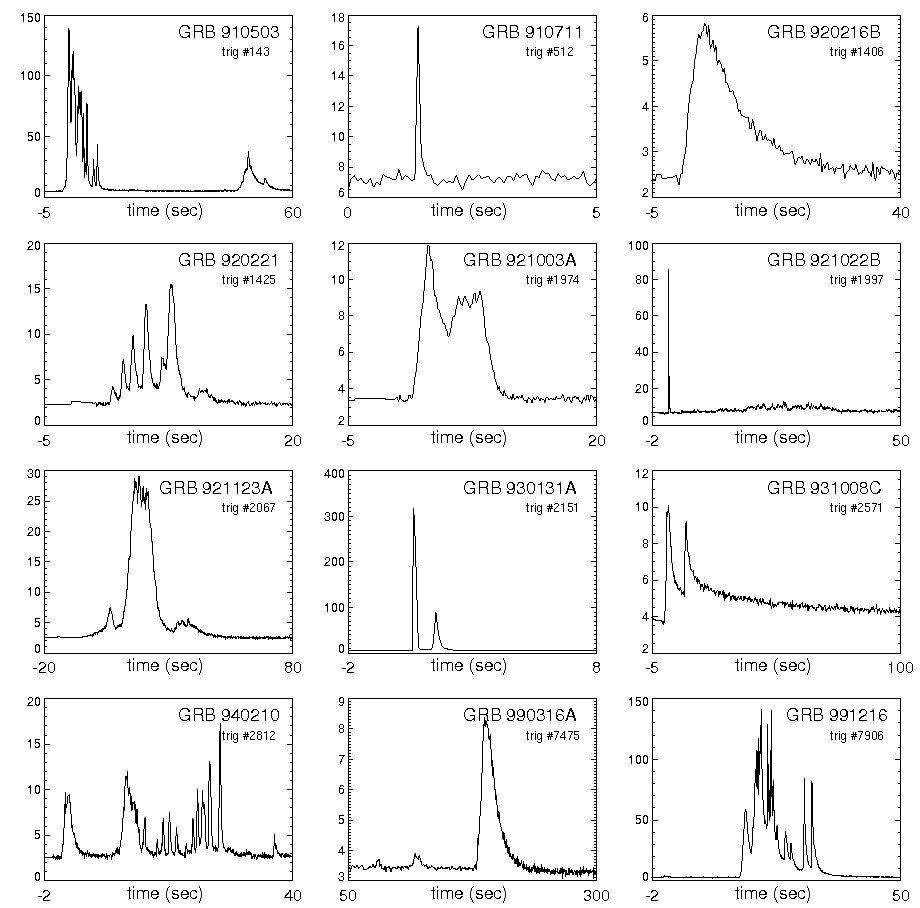
We already had the hint from the analysis that received light in
de Sitter space starts blue-shifted. Indeed, it starts infinitely
blue-shifted (so, even higher frequencies than gamma-rays). What about
its intensity? Call the “intensification” the ratio of received
power per unit area to emitted power per unit solid angle. We computed
the intensification and found that it starts infinite. Both blue-shift
and intensification subsequently decay (with the blue-shift turning to
red after the blueshift period
More general space-times have similar effects (though not the Friedmann universes with big bang). So we propose that many GRBs are just the natural way that any emitter coming “over the horizon” should look in a non-big-bang universe. This fits with many observations, though is not accepted by the mainstream astrophysics community.
The nonacceptance of our explanation of GRBs was reflected in our attempts to publish. We had a paper on GRB ready in 2011 but it was rejected by the journals we tried over several years. To attempt to get some visibility, we also produced a punchy short version, but it was again rejected by all the places we tried (it is included as Appendix F in [6]). Eventually the long version was accepted as [4]. When I realised I could also explain observations that GRBs are not polarised, I rewrote the short version to include that, but the journals I tried rejected it, and to cap it all, so did arXiv! The best I found so far was to put it on ResearchGate [7].
6. Big bang
As mentioned near the beginning, a central feature of Colin’s work is to reject the big bang. Colin bases this on a number of arguments. One is that there are globular clusters that are dated to be 15 billion years old, thus before the big bang. Another is that the Hubble ultradeep field images show fully formed galaxies so far in the past that he says they did not have time to form.
My take on the big bang is that even if the conditions for the Penrose–Hawking singularity theorems are satisfied, the theorems do not say that everything came out of a singularity, only that there are some incomplete backward geodesics. The strongest version I have seen is that there is a 3-parameter family of incomplete timelike backward geodesics [e7]. That leaves plenty of room for the rest of the universe to keep going backwards as long as it likes.
I believe that the idea that all came from a singularity is due to over-reliance on the Friedmann solutions of general relativity (starting with the “primeval atom” theory of Lemaître, who rediscovered them). They are a special class of solutions in which there is a preferred time-coordinate and the spatial slices are homogeneous and isotropic. Under plausible physical conditions, they shrink to a singularity in finite backwards time. Friedmann’s solutions were a very important step in the understanding of the cosmological consequences of general relativity (in keeping with their importance, they were rediscovered by not only Lemaître but also Robertson and then Walker), but general relativity has many more solutions. In particular, a key consequence of Einstein’s genius was to liberate us from the concept of an absolute time and it is a pity that cosmologists put it back in. In particular, even if there is a preferred velocity field in space-time, in general the perpendicular plane field is not integrable (the Frobenius condition fails) so it does not define spatial slices nor an absolute time. We need to go beyond Friedmann’s solutions (and not just to the various Bianchi universes [e11]).
7. Cosmic microwave background
The largest thing that remains for Colin or successors to firm up is
an explanation of the cosmic microwave background (CMB) without a big
bang. The standard big-bang story is that the universe was filled by a
hydrogen plasma and electromagnetic radiation in approximate
equilibrium, but as the universe expanded, the density and temperature
fell, and at a temperature of about
Consider the bundle of null geodesics that reach us in some solid angle of directions over the product of some transverse surface (which I will call “aperture”) and time interval. Follow them backwards. It is conventional to talk about going backwards along light rays for a given time or a given distance, but that requires choosing a reference frame. In a Friedmann universe (or with a natural observer field) there is a preferred notion of time, but for a general Lorentzian metric there is not. For time-like geodesics one has an intrinsic notion of time between two points along them, namely the proper time, but the intrinsic time between any two points along a null geodesic is zero. Nonetheless, there is a notion of affine parameter for a null geodesic, that is, a parametrisation that is intrinsic up to shift of origin and linear scaling. We choose to fix the origin of an affine parametrisation to be where the null geodesic crosses the product of the aperture and time interval, and choose the scaling to make the parametrisation agree with our proper time in a local frame.
In general, the bundle of null geodesics diverges as one follows it
backwards in affine parameter. At first it diverges linearly because
of the solid angle of directions, but further away one can expect
typical nearby pairs of null geodesics to separate exponentially
because of deviations of the metric from a simple one. This is because
the equations for null geodesic flow on a Lorentzian space-time
Furthermore, the frequency spectrum we see is the result of some
random redshifting. The redshifting can be described by
parallel-transporting the emitter velocity (or the velocity of a frame
in which the frequency distribution is known) along the null geodesic
to the receiver, where it can be written as
One thing that needs estimating is the Lyapunov time, the affine
parameter change for one e-folding in separation of null geodesics,
that determines how fast the mixing occurs in backwards time. There is
plenty of evidence for optical distortions, some of which is surveyed
by Colin in
([6], Appendix E),
generally attributed to passage of light
rays near something particularly massive or through dark matter
distributions, but some
of which
could be from gravitational waves.
Figure 7 shows a more recent example.
These distortions are already seen at redshifts of order 1, but more
relevant is probably so-called “weak-lensing”, which is
distortion
due to passage through general inhomogeneities. Objects can be
identified to at least
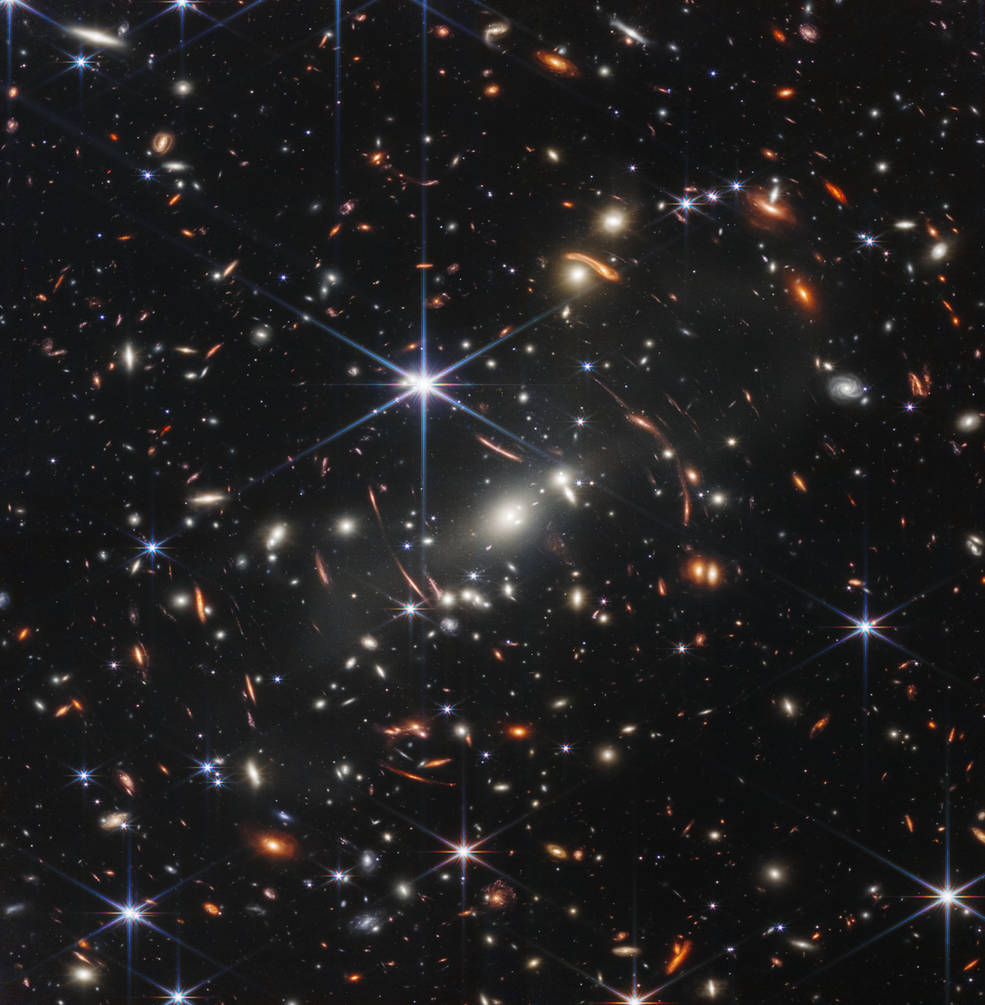
After that, the big question is why does the resulting averaged
radiation have the observed temperature of
And can we explain the observed slight anisotropies of the CMB? A big success of standard cosmological theory is to explain them in terms of (principally) acoustic oscillations in the plasma before the transition to atoms [e15], [e18]. Although the theory of the amplitude of acoustic oscillations depends on the hypothetical notion of inflation, we have a steep challenge to do better! Nevertheless, perhaps the spectrum of anisotropies from our mechanism is governed by the same law; the Sachs–Wolfe anisotropy effects of gravitational inhomogeneities (and a variant proposed by Rees and Sciama) are called secondary in the standard theory.
8. Other topics
There is a lot more in Colin’s paper [1] and in his book [6], for example on the structure of galaxies, the abundance of elements, and on quasars and galaxies as life forms. I don’t feel competent to review those, but recommend interested readers to study the book.
It is worth mentioning that there are other books challenging standard cosmology, even by leaders in the field like Roger Penrose [e16] and Steinhardt & Turok [e14]. It seems permitted to such authors to make far wilder speculations than Rourke’s.
9. Colin
I close with some personal remarks about Colin. He is very articulate (I remember him destroying other people’s arguments in staff meetings). He is ready to question received dogma: we need more like him. And it is fun to discuss ideas with him.
Appendix: Comments on Appendix C of “The geometry of the universe” on quasars
As stated in Appendix C of [6], the work on quasars reported there is still in progress and is based on a draft paper [5] that we intend to get into a publishable form one day.
Expanding on what is indicated in his Appendix C, the main thing we
felt is needed is a suitable model of the infalling gas to determine
profiles of density, temperature and ionisation fraction as functions
of radial coordinate. Mestel
[e3]
gives an idea of what is involved but
simplifies by proposing two shells of constant temperature. Our
purpose is to find the location from where the outgoing radiation can
be considered as coming. It is given by
I think there is a simpler problem that needs
fixing too, namely, (C.13) needs modifying to
I believe also that in (C.6) both the accretion rate